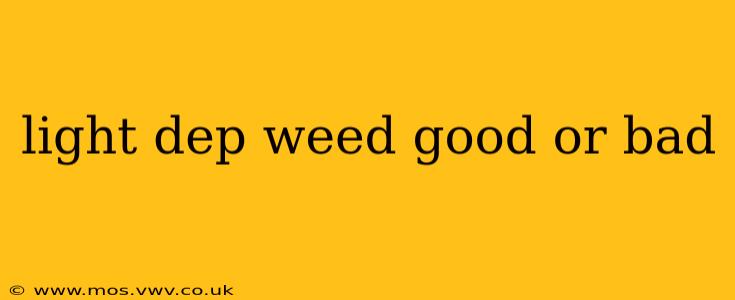Light Dep Cannabis Cultivation: Good or Bad? A Comprehensive Overview
The question of whether light deprivation (light dep) cannabis cultivation is "good" or "bad" is complex and depends heavily on context. It's not inherently good or bad, but rather a technique with both advantages and disadvantages. Understanding these nuances is crucial for making informed decisions. This article will explore light dep in detail, addressing common questions and concerns.
What is Light Dep Cannabis Cultivation?
Light deprivation involves manipulating the light cycle experienced by cannabis plants to force early flowering. Normally, cannabis plants flower when the days get shorter in the fall. Light dep mimics this natural process by artificially shortening the daily light period, typically using large blackout cloths or structures to cover the plants during nighttime hours. This tricks the plant into thinking autumn has arrived, prompting it to begin the flowering stage sooner.
What are the advantages of light dep cannabis cultivation?
- Earlier Harvest: The primary advantage is a faster harvest. By forcing flowering, growers can obtain multiple harvests per year in climates with longer growing seasons. This significantly boosts yields in a given timeframe.
- Increased Yields (Potentially): While not guaranteed, carefully managed light dep can potentially lead to higher yields compared to outdoor plants grown without manipulation, particularly in regions with shorter growing seasons. This is because the plants are optimized to focus energy on flower production.
- Improved Control Over the Environment: Light dep allows for more environmental control. Growers can manage factors like temperature, humidity, and pests more effectively in controlled environments.
- Protection from Pests and Diseases: Growing indoors or in a highly managed outdoor setup can offer protection from various pests and diseases that commonly affect outdoor cannabis plants.
What are the disadvantages of light dep cannabis cultivation?
- Increased Costs: The additional equipment and labor required for light dep (e.g., blackout cloths, structures, manpower for covering and uncovering) significantly increase the overall cost of cultivation.
- Complexity and Skill Required: Successfully implementing light dep requires specialized knowledge, precision, and careful planning. Mistakes can lead to poor yields, plant stress, and even crop failure.
- Potential for Stress on Plants: Improperly implemented light dep can stress plants, leading to lower yields and reduced quality. Consistency is key.
- Environmental Concerns (Potential): The energy consumption associated with managing the light cycle and maintaining a controlled environment can contribute to higher carbon footprints if not managed sustainably.
Is light dep better than natural outdoor growing?
There's no universally "better" method. Light dep offers advantages in terms of timing and potential for control, but it comes at a higher cost and requires more expertise. Outdoor growing utilizes natural sunlight, reducing energy costs, but yields and timing are subject to weather and seasonal variations. The best approach depends on the grower's goals, resources, and climate.
Can light dep be used with different cannabis strains?
While light dep is applicable to many strains, some might respond better than others. It's crucial to select strains suited for the grower's environment and light cycle manipulation capabilities. Research specific strain characteristics before attempting light dep.
What are some common mistakes to avoid with light dep?
- Inconsistent light cycles: Even minor inconsistencies can severely stress plants.
- Inadequate blackout: Any light leaks during the "night" period can disrupt the flowering process.
- Poor ventilation: Proper air circulation is crucial to prevent mold and other issues.
- Neglecting plant health: Regular monitoring and attention to plant needs are essential.
Conclusion:
Light dep cannabis cultivation is a powerful technique with significant potential benefits, but it's not a magic bullet. It requires careful planning, expertise, and resources. Weighing the advantages and disadvantages carefully and making informed decisions based on your specific circumstances is crucial for successful implementation. Remember that local laws and regulations regarding cannabis cultivation must always be followed.
